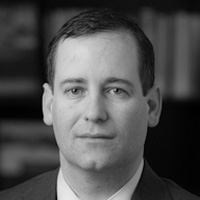In Iraq, I led a motley crew of soldiers, civilians, and contractors, who lived outside the wire in downtown Baquba, advising the government of Iraq’s volatile Diyala province in 2005-06. My team drove Iraq’s roads, walked Iraq’s streets, and regularly encountered improvised explosive devices, small arms fire, mortar fire, and other dangers during that dark and deadly time in Iraq. We wore body armor, carried semi-automatic rifles and pistols, and drove in armored Humvees, sometimes with drones or helicopters above.
In other words, we served in one of Iraq’s bloodiest cities, during the most violent time of the war, with the same gear that a civilian police department is now using in the small American town of Ferguson, Missouri, to quell civic disturbances there. Our wars have come home.
American police have become increasingly militarized for decades, in a story told brilliantly by scholar Radley Balko in his primer on the subject. However, for much of the past decades, paramilitary SWAT teams were balanced by community policing efforts, resulting in a mostly civilian, peaceful approach to law enforcement.
ADVERTISEMENT
Things began to change during the 1980s, when the nation’s leadership declared a “war on drugs,” and began to militarize its approach accordingly. Congress allowed the Pentagon to give warfighting gear to police departments, and also created a number of exceptions to the historical rule precluding military involvement in law enforcement. Police departments raced to apply for federal funding to harden their communities and police forces against an entire spectrum of threats not previously contemplated. Sophisticated command and control systems migrated from the military to law enforcement, alongside powerful surveillance and investigative tools first developed for the military and intelligence community. Police departments touted their use of military counterinsurgency techniques, learned from Army field manuals and returning veterans. And, most recently, as the wars in Iraq and Afghanistan have wound down, the Defense Department has aggressively transferred combat gear to civilian law enforcement agencies at home – more than $400 million-worth in 2013 alone. According to a USA Today report, “police forces in the same county as Ferguson received advanced rifle sights and night vision equipment between 2012 and 2014.”
The net effect is a Ferguson police department in name only. In terms of its equipment, organization, and deployment methods, the Ferguson force looks more like an infantry or military police company in Iraq. Its police wear the same body armor; carry the same semi-automatic M4 carbines and semi-automatic pistols; patrol in similar fire-team and squad formations; and employ similarly aggressive tactics towards a population perceived to be hostile.
Moreover, to a police force with such a military arsenal, every problem potentially looks like one that can be solved with military force. In hindsight, the Ferguson police department’s heavy-handed response to protests arguably caused the situation to escalate into the crisis that exists today. A lesser-armed police department might have used less confrontational, more community-oriented policing strategies to restore order, and been far more effective (and efficient) in the long run.
To be sure, there is a legitimate police purpose to much of this military gear. When used properly, body armor and other protective equipment enables police to use less force; similarly, non-lethal munitions can be effectively used to quell a crowd with far less force and suffering than the alternative.
But when used as in Ferguson, this military gear transforms the police department into an occupying army, and enables the police to act with such speed and violence so as to destroy any meaningful right to peaceably assemble or address grievances towards government. The key difference lies in how the police choose to use this gear – whether as civilian police, or as infantrymen with badges.
The great irony is that in Iraq, we rarely employed such hostile tactics, generally only using force when attacked. As combat advisers, our mission was to build Iraqi police and government capacity, not to conduct offensive combat operations. We carried rifles, machine guns, grenades, and other firepower, and used it when necessary to fight al Qaeda in Iraq, Shiite militants, or others who attacked us.
However, we sharply distinguished between the Iraqi civilians we were there to serve and protect, and those militants we sought to defeat (and sometimes kill or capture). Towards the former, we adopted as friendly a posture we could, often removing our body armor and laying down our weapons in order to share tea or lunch, or doing whatever we could to show trust and build rapport.
If only the Ferguson police would learn from our experience in Iraq and Afghanistan, and the paradox of force stated so succinctly in the Army’s counterinsurgency field manual: “Sometimes, the more force is used, the less effective it is.”





